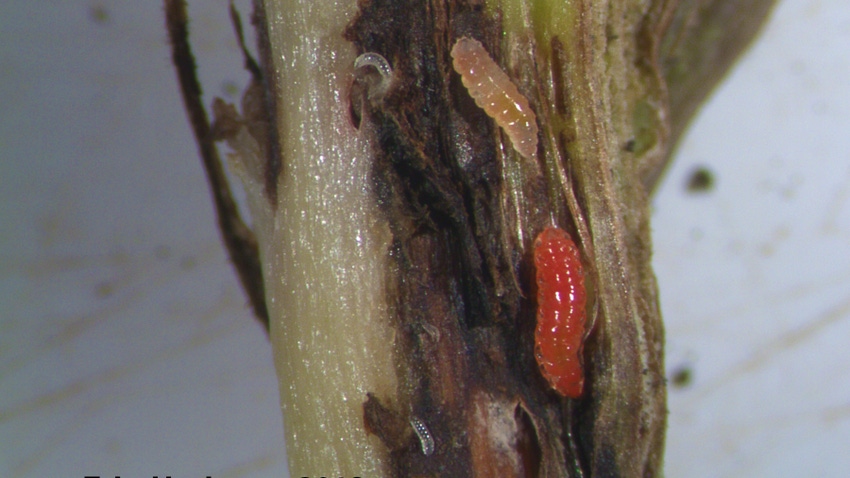May 11, 2023

by Ashley Dean and Erin Hodgson
Since 2018, soybean gall midge has caused issues for soybean farmers in Iowa and beyond. Currently, the worldwide distribution includes 155 counties in five states in the Midwest: Iowa, Minnesota, Missouri, Nebraska and South Dakota. Although we may never know the origin of the species, larvae have been found feeding on several legume hosts, including soybean, alfalfa, sweet clover and dry beans. The adults are small, long-legged flies that do not feed. They first emerge from the soil in late May to early June, fly to a nearby soybean field, and lay eggs in the stem near the base of plants. Once the eggs hatch, the larvae (maggots) feed on the internal stem tissue as they develop through three instars: small, clear first instars; milky-white second instars; and bright orange third instars. Once larvae have completed development, they flick themselves out of the stem and into the soil to pupate. The entire life cycle takes about a month to complete, and there are likely three overlapping generations per year.
Soybean plants become susceptible to infestation by soybean gall midge once they reach the V2 (two trifoliates) growth stage, because stem elongation occurring at this time leads to fissures developing near the base of the stem. Those fissures serve as an entry point for the female adult soybean gall midge to deposit eggs. Larval feeding within the stem results in swollen, corky stems that may lead to wilting and plant death.

PLANT DAMAGE: The black lesion at the base of the soybean stem here was caused by soybean gall midge larval feeding. (Ashley Dean)
These symptoms develop rapidly: our observations have been that larvae can be found in soybean plants two weeks after adult emergence, and plant wilting and death starts one to two weeks later. Because these symptoms can be easily mistaken for plant pathogens, stems should be peeled open to confirm the presence of soybean gall midge larvae.
Scouting tips
Because the adults are weak fliers, soybean gall midge infestations tend to be worse at the field edge near where soybean was grown the previous year. Early in the season, when plants are small, it is easy to see wilted or dead plants near the edge of the field. This becomes less obvious later in the season, because green plants that are not infested or not yet wilted can hide dead plants or hold up plants and prevent them from lodging. In either case, we recommend scouting should begin at V2 and fields should be checked regularly. Prioritize scouting fields that share a border with a field where a soybean gall midge infestation was noted last year. If soybean gall midge has not been confirmed on the farm, begin scouting the field borders near where soybean was planted last year. Check the first few rows for swollen stems, wilted or dead plants, or dark lesions near the base of the stem. If lesions are found, peel them back with a knife or fingernail to expose any larvae feeding within the stem. Yield losses are variable between and within fields. Mild infestations may just be a few dead plants scattered along the field edge, while severe infestations may result in 100% yield loss at the field edge, with yield increasing toward the field interior. Small, irregularly shaped fields are more likely to experience severe yield loss across the entire field than large, rectangular fields.
No research-based management ideas — yet
Since the confirmation of soybean gall midge as a new pest of soybean, many research projects have been underway to attempt to manage this pest. Insecticides are typically the go-to management strategy for field crop pests, but several aspects of soybean gall midge biology have made this difficult; adults are small and non-feeding, and they emerge for an extended period (more than 30 days), making it difficult to target adults for insecticidal management before they lay eggs in soybean. Additionally, larvae are feeding inside of the stem, offering them protection from the mostly contact-based insecticide options available to farmers. Researchers have discovered some tactics that may offer some protection from injury by soybean gall midge, including delayed planting, host plant resistance and biological control. Continued research in these areas as well as other cultural tactics, including various forms and timings of tillage, will further our understanding of soybean gall midge and provide some management recommendations in the future.
Call to action
If you discover soybean gall midge larvae in a county that is not yet marked as infested on the distribution map on soybeangallmidge.org/soybean-gall-midge-distribution, please reach out to the authors or your local Extension entomologist to help us track the distribution.
Dean and Hodgson are Iowa State University Extension entomologists.
You May Also Like




